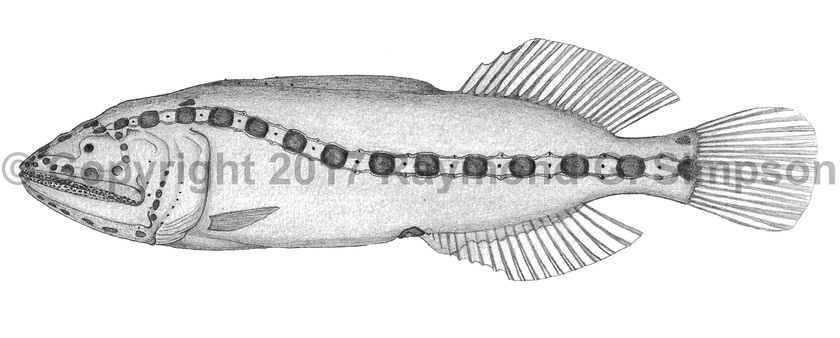
Common Name
Storer's Whalefish
Year Described
Goode & Bean, 1895
Identification
Dorsal Fin: 19-22
Anal Fin: 15-18
Pectoral Fin: 17-21
Lateral Line Pores: 11-14
Gill Arches: 4
Vertebrae: 38-42
Genus diagnosis after Paxton (1989) for females:
Body rather robust with a huge head (third of body length). Snout rounded. Head wider than body. Eye tiny. Nasal organ small. Jaws slightly concave to straight on upper and concave on lower. Four distinct gill arches with a small slit behind the fourth. Gill tooth plates separate. Lateral line conspicuous with large round pores inside a channel with raised rim. Lateral scales round and flat without projections. Lateral pores lack dermal flaps. Scattered neuromasts on lateral line canals and on head and jaw. Lateral line system continues onto head as a series of pores and sensory openings. Additional pores on lower jaw and snout. Jaw teeth tiny in broad bands. Dorsal and anal fins located far back on body, with bases slightly elevated. Cavernous tissue located anterior to the anus but never to anal fin. Caudal fin with 16 principle rays. Pelvic fin absent. Pectoral fin small and inserted low on body. Body flabby and scaleless except for large, diagnostic scales associated with the lateral line canals. Dorsal midline with a fleshy keel. Ventral midline with paired, fleshy keels. Anal fin with a long scalloped fleshy flap along base. Dorsal fin base always longer than anal fin base with at least a few more rays.
Males unknown.
Larvae (described as Parataeniophorus bertelseni) are slender with a enlarged tape-like extension of the caudal fin.
Color
Preserved material dark brown with lighter interior of the mouth and gill cavity. Gut and pores darker brown.
Size
Maximum size to 128.5mm SL.
Habitat
Adults mainly bathypelagic, with smaller individuals found in shallower water. Captures range from 650 to over 1550m.
Range
Widely distributed in the Atlantic Ocean: known from off the northeastern U.S. to off Uruguay, including the Caribbean and the Gulf of Mexico). Also the Indian and Pacific Ocean (both sides).
References
Afonso, G. V. F., Di Dario, F., Eduardo, L. N., Lucena-Frédou, F., Bertrand, A., & M.M. Mincarone. 2021. Taxonomy and distribution of deep-sea bigscales and whalefishes (Teleostei: Stephanoberycoidei) collected off northeastern Brazil, including seamounts and oceanic islands. Ichthyology & Herpetology, 109(2), 467-488.
Harry, R.R. 1952. Deep-sea fishes of the Bermuda oceanographic expeditions. Families Cetomimidae and Rondeletiidae. Zoologica, Scientific Contributions of the New York Zoological Society v. 37 (pt 1, no. 5): 55-72, Pl. 1.
Johnson, G.D., J.R. Paxton, T.T. Sutton, T.P. Satoh, T. Sado, M. Nishida, & M. Miya. 2009. Deep-sea mystery solved: astonishing larval transformations and extreme sexual dimorphism unite three fish families. Biology Letters, 5: 235–239.
Paxton, J.R. 1989. Synopsis of the whalefishes (family Cetomimidae) with descriptions of four new genera. Records of the Australian Museum v. 41: 135-206.
Tolley, S.G., J.V. Gartner, Jr. & T.M. Lancraft. 1989. Whalefishes (Beryciformes: Cetomimoidei) of the Gulf of Mexico. Bulletin of Marine Science v. 45 (no. 3): 671-677.
Other Notes
Johnson et al. (2009) discovered that the families Mirapinnidae and Megalomycteridae correspond to the larval and male stages respectively of female Cetomimidae. Genetic data placed the material of Parataeniophorus bertelseni with the female material of Ditropichthys storeri.